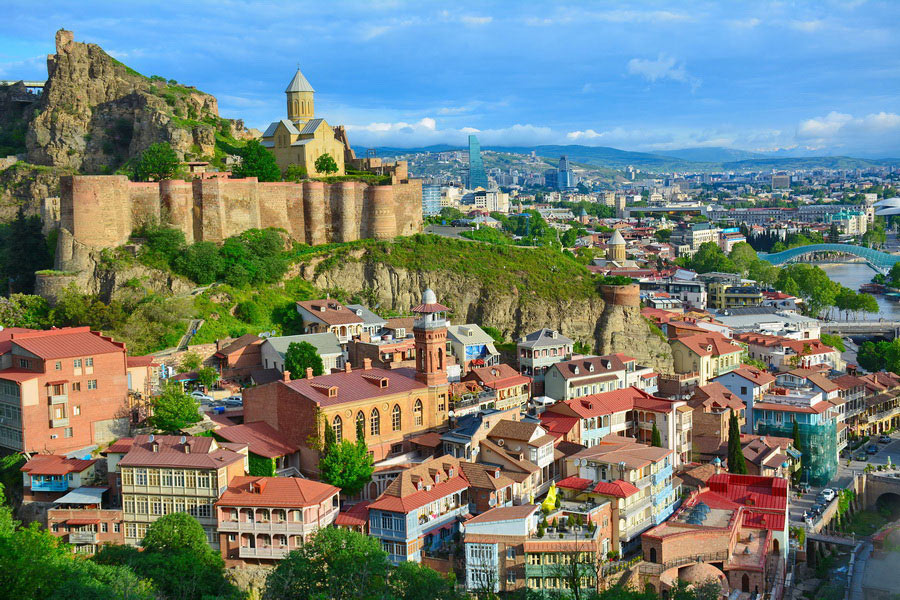Tbilisi, Georgia: Bridging Centuries with Timeless Charm, Cultural Richness, and Transcendent Beauty

Introduction:
Tbilisi, the vibrant capital of Georgia, stands at the crossroads of history, where ancient traditions converge with modern aspirations, creating a city that pulsates with life, culture, and an undeniable sense of resilience. Nestled along the banks of the Kura River and framed by the majestic Caucasus Mountains, Tbilisi is more than a geographical capital; it is the heart and soul of a nation. In this extensive exploration, we uncover the layers of Tbilisi, from its historic landmarks and diverse neighborhoods to its cultural vibrancy, culinary treasures, and the unique blend of old-world charm and contemporary spirit that define this enchanting city.
Section 1: Old Town (Altstadt) – Echoes of Centuries Past
1.1 Narikala Fortress: Dominating the skyline, Narikala Fortress is an ancient sentinel that has stood witness to the ebb and flow of Tbilisi’s history. Offering panoramic views of the city, the fortress unfolds tales of conquests, cultural exchanges, and the enduring spirit of a people determined to preserve their heritage.
1.2 Metekhi Church of the Assumption: The Metekhi Church, perched on the cliff overlooking the Kura River, is a testament to Tbilisi’s spiritual legacy. Dating back to the 13th century, this historic church blends architecture with devotion, embodying the fusion of medieval artistry and religious significance.
1.3 Sioni Cathedral: Sioni Cathedral, a sacred edifice nestled in the heart of Old Town, stands as a beacon of Georgian Orthodoxy. With its iconic frescoes, ornate iconostasis, and the revered cross of St. Nino, the cathedral serves as a spiritual anchor for both locals and pilgrims.
Section 2: Rustaveli Avenue – Modern Pulse, Timeless Elegance
2.1 Rustaveli Avenue: Rustaveli Avenue, Tbilisi’s central thoroughfare, mirrors the city’s transformation into a modern metropolis while retaining its historical significance. Lined with government buildings, theaters, and cultural institutions, the avenue serves as a dynamic stage where past and present gracefully coexist.
2.2 Tbilisi Opera and Ballet State Theatre: The Tbilisi Opera and Ballet State Theatre, an architectural jewel along Rustaveli Avenue, embodies the city’s commitment to the arts. The neo-Moorish façade and opulent interiors provide a fitting backdrop to world-class performances, showcasing the enduring cultural heritage of Tbilisi.
2.3 Georgian National Museum: The Georgian National Museum, located on Rustaveli Avenue, preserves and presents the rich tapestry of Georgia’s history. From ancient artifacts to contemporary exhibits, the museum invites visitors to embark on a journey through time, unraveling the threads that weave the story of Tbilisi and its people.
Section 3: Diverse Neighborhoods – A Mosaic of Culture
3.1 Sololaki District: Sololaki, with its narrow winding streets and eclectic architecture, is a bohemian enclave that captures the artistic spirit of Tbilisi. Art galleries, vintage boutiques, and charming cafes contribute to the district’s reputation as a cultural hub where creativity flourishes.
3.2 Vera District: Vera, a residential district known for its leafy avenues and Art Nouveau architecture, offers a tranquil escape in the heart of Tbilisi. Parks, embassies, and cultural spaces create a harmonious ambiance, providing residents and visitors with a retreat from the city’s lively pace.
3.3 Avlabari: Avlabari, situated beneath Narikala Fortress, is a neighborhood that fuses tradition with modernity. The district is home to the Holy Trinity Cathedral of Tbilisi, a symbol of Georgia’s spiritual renewal, and the Presidential Palace, underscoring the area’s significance in the nation’s narrative.
Section 4: Culinary Delights – Gastronomic Symphony
4.1 Khachapuri and Khinkali: Tbilisi’s culinary scene is a symphony of flavors, with khachapuri (cheese-filled bread) and khinkali (dumplings) standing out as iconic Georgian dishes. From the warm embrace of Acharuli khachapuri to the savory delight of khinkali, Tbilisi’s culinary offerings celebrate the region’s gastronomic heritage.
4.2 Sulphur Baths in Abanotubani: Abanotubani, the historic district renowned for its sulphur baths, has been a cornerstone of Tbilisi’s communal life for centuries. The distinctive domes and steam rising from the baths create an otherworldly ambiance, inviting locals and visitors to indulge in the therapeutic and social traditions of this unique cultural enclave.
4.3 Wine Culture: Tbilisi, nestled in the cradle of ancient winemaking traditions, embraces a vibrant wine culture. With its unique qvevri winemaking method and diverse grape varietals, Georgia’s capital invites oenophiles to savor the fruits of the region’s vineyards and experience the conviviality of traditional wine toasting.
Section 5: Futuristic Landmarks – A Glimpse into Tomorrow
5.1 Bridge of Peace: The Bridge of Peace, an iconic pedestrian bridge spanning the Kura River, symbolizes Tbilisi’s bridge between the past and the future. The modern design, adorned with thousands of LED lights, transforms the bridge into a mesmerizing spectacle at night, reflecting the city’s forward-looking spirit.
5.2 Sameba (Holy Trinity) Cathedral: Sameba Cathedral, a modern architectural marvel, rises with grace and grandeur on the left bank of the Kura River. Completed in 2004, the cathedral stands as a symbol of Tbilisi’s spiritual renewal and the harmonious coexistence of tradition and contemporary aspirations.
5.3 Tbilisi Public Service Hall: The Tbilisi Public Service Hall, with its futuristic design, exemplifies the city’s commitment to efficient public services and modern governance. The building’s innovative architecture and technology integration underscore Tbilisi’s determination to embrace progress while preserving its cultural heritage.
Conclusion:
Tbilisi, a city that bridges centuries with its timeless charm, cultural richness, and transcendent beauty, is more than a geographical capital; it is the soul of Georgia. From the echoes of Narikala Fortress to the modern pulse of Rustaveli Avenue, Tbilisi invites residents and visitors to embark on a journey through time, immersing themselves in a tapestry of history, culture, and gastronomic delights. As Tbilisi continues to evolve, it remains a testament to the resilience and spirit of its people, creating a city that beckons travelers to experience the magic of a place where tradition and modernity dance in perfect harmony.




